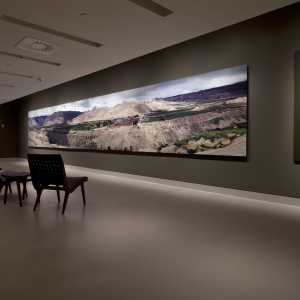
We all knows that actions have consequences. We see it in the little things, like heating water to a boil, as well as large-scale events, such as global warming and climate change. The word karma defines this cause and effect that we experience in our lives. While karma is often thought of on a personal level, the world is beginning to feel the collective karma of our actions as the threat of a climate crisis becomes very real.
Karma plays a huge role in the art featured in the Rubin Museum’s collection of art from the Himalayan region. Traditionally, Himalayan cultures have had strong connections to their environment, personifying mountains and lakes as gods and goddesses. If these forces weren’t properly respected, the deities would strike back with the power of nature.
Below you’ll find examples from our art collection exploring the connections between cause, effect, and nature, providing an inspirational model for thinking about our relationship with our struggling planet.
Gods Who Control the Earth and Skies

Clouds hold a special significance in Nepal because of their association with the life-bringing monsoon rains. In this sculpture of Indra, the Hindu king of the gods, you’ll notice an intricate cloud motif on his crown. Indra is from the ancient Indian Vedic tradition, which was influenced by a largely agricultural society and is still practiced in Nepal to this day. The Nepalese remain dependent on the annual monsoon rainfalls, which are growing increasingly erratic due to climate change.

This sculpture features Kula Khari, protector of a mountain known as Lodrak, which is located south of Lhasa near the Bhutanese border. Locals would pray to this protector god to prevent natural disasters. Here the god rides a yak, highlighting the unique landscape of the mountainous Himalayan terrain. The artist who created this sculpture emphasized this environment by cleverly using simple, pointed, staggered forms around Kula Khari to indicate the surrounding mountains. The disproportionate scale of these topographical contours to Kula Khari, his yak, and the architecture behind him conveys the sense of a remote temple in the mountains. When a natural disaster occurs in Tibet, the local populace attributes it angered deities.
Nature Motifs in Himalayan Art

Motifs like those in the image above emphasize Buddhism’s everlasting connection to nature. Marichi, the Goddess of the Dawn, depicted in this sculpture, is most commonly portrayed in a chariot of the sun pulled by seven pigs, removing obstacles with her radiant light. This sculpture presents her as an Indian princess, holding a vajra—the Buddhist symbol resembling a lightning bolt—and a branch of the sacred ashoka tree, which is said to represent beauty and seduction.

Make an offering to this sculpture and you’ll form a karmic connection with Green Tara. The goddess represents the potential for life, and with life, the capacity for people to change and transcend. In this sculpture of Tara, lush imagery of birds, flowers, and trees bloom behind her.
Despite the unusual style of this brass sculpture, the iconography follows age-old conventions. Seated in a posture of royal ease with a light sway and one leg hanging downward, Green Tara is supported by a branch of her lotus seat. The lotus is one of the most common symbols in Himalayan cultures, representing enlightenment. The goddess also performs the hand gesture of giving and holds the stalk of a blue lily in her left hand, which was once painted red.
Using Materials from the Earth
Most materials used for creating paintings and sculptures come directly from the earth, deepening the connection between Himalayan art and the environment. Visit our Materials and Techniques section on the second floor to see the process by which thangkas, or Tibetan Buddhist scroll paintings, are created. You’ll notice the brightly colored paints made from crushed minerals and glue that artists use to bring paintings alive.
Add Your Thoughts
Comments are moderated, and will not appear on this site until the Rubin has approved them.



